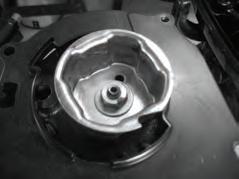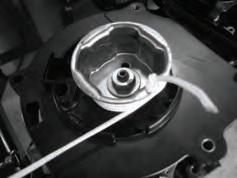
5 minute read
Troubleshooting
A problem in the fuel, compression, or ignition systems can cause poor starting, loss of power, or other problems. This section describes basic checks and possible remedies.
ENGINE WILL NOT START OR OPERATE
Q: Is engine stop switch lanyard not attached? A: Attach lanyard.
Q: Is throttle speed set incorrectly? A: Set throttle speed to 1/4 or less, unless the water is cold, then set to 1/4 - 1/2 throttle. See pg 10.
Q: Is shift lever in gear? A: Shift to neutral.
Q: Is propane tank empty, or fully connected? A: Shake the tank to feel for liquid, then be sure it is fully connected.
Q: Is the spark plug fouled or incorrect type? A: Inspect spark plugs. Clean or replace with recommended type.
Q: Is spark plug cap fitted incorrectly? A: Check and re-fit caps.
Q: Is ignition wiring damaged or poorly connected? A: Check wires for wear or breaks. Tighten all loose connections. Replace worn or broken wires.
Q: Possible faulty ignition parts? A: Have serviced by LEHR dealer.
Q: Possible faulty internal engine parts? A: Have serviced by a LEHR dealer.
ENGINE IDLES IRREGULARLY OR STALLS
Q: Is propane tank empty? A: Check tank fluid level by shaking it.
Q: Is spark plug fouled or incorrect type or gap? A: Inspect spark plug. Clean or replace with recommended type.
Q: Is the Idle speed set correctly? A: Adjust Idle screw or have serviced by LEHR dealer.
Q: Are fuel joints connected correctly? A: Check for any leaks or smell of propane. Tighten any loose fittings. Replace any faulty fuel lines or connectors.
Q: Is thermostat faulty or clogged? A: Have serviced by LEHR dealer.
Q: Is carburetor faulty? A: Have serviced by LEHR dealer.
Q: Is engine oil level low? A: Check oil level and add oil if needed.
ENGINE POWER LOSS
Q: Is fuel supply running low? A: Shake propane bottle or tank to determine if propane level is low. If so, replace tank or operate at reduced throttle settings until fuel supply is replenished.
Q: Is fuel system obstructed? A: Check for pinched or kinked fuel line or other obstructions in fuel line.
Q: Is propeller damaged? A: Have propeller repaired or replaced.
Q: Is propeller pitch or diameter incorrect? A: Install correct propeller to operate outboard at its recommended speed.
TROUBLESHOOTING
Q: Is trim angle correct? A: Adjust trim angle to achieve most efficient operation.
Q: Is motor mounted at incorrect height on transom? A: Have motor adjusted to proper transom height.
Q: Is boat bottom fouled with marine growth? A: Clean bottom of boat.
Q: Are weeds or other foreign matter Tangled on gear housing? A: Remover foreign matter and clean power unit.
Q: Is spark plug gap incorrect? A: Inspect and adjust as specified.
Q: Is ignition wire damaged or poorly connected? A: Check wires for wears and breaks.
Q: Have electrical wires failed? A: Have serviced by a LEHR dealer.
ENGINE VIBRATES EXCESSIVELY
Q: Is propeller damaged? A: Have propeller repaired or replaced.
Q: Is propeller shaft damaged? A: Have serviced by a LEHR dealer.
IMPACT DAMAGE
WARNING: The outboard motor can be seriously damaged by a collision while operating or traveling. Damage may make the outboard motor unsafe to operate.
If the outboard motor hits an object in the water, follow the procedure below.
1. Stop the engine immediately. 2. Inspect the control system and all components for damage. Also inspect boat for damage. 3. Whether damage is found or not, return to the nearest harbor slowly and carefully. 4. Have the outboard motor inspected before operating it again.
STARTER WILL NOT OPERATE
If the start mechanism does not operate (the engine cannot be cranked with the starter), the engine can be started with an emergency starter rope.
WARNING: • Use this procedure only in an emergency and only to return to the port for repairs. • Make sure the gear shift lever is in neutral. Otherwise the boat could unexpectedly start to move, which could result in an accident. • Attach the engine stop switch lanyard to a secure place on your clothing, or your arm or leg while operating. • Do not attach the lanyard to clothing that could tear loose. Do not route the cord where it could become. entangled, preventing it from functioning. • Avoid accidentally pulling the lanyard during normal operation. Loss of engine power means the loss of most steering control. Also without engine power, the boat could slow rapidly. This could cause people and objects in the boat to be thrown forward. • Be sure no one is standing behind you when pulling the starter rope. It could whip behind you and hurt someone. • An exposed, rotating flywheel is very dangerous. Keep loose clothing and other objects away when starting the engine. Do not touch the flywheel or other moving or parts when the engine is running.
TROUBLESHOOTING
EMERGENCY ENGINE START
1. Remove the top engine cover. 2. Remove the starter cover by unscrewing the bolts. 3. Make sure the engine is in neutral and that the switch is attached to the engine shut off switch. 4. Insert the knotted end of the emergency starter rope in the notch into the flywheel rotor and wind the rope several times clockwise.
NOTE: If the rope is too long after winding it around the flywheel, shorten at the handle.
5. Pull the rope slowly until resistance is felt. 6. Give a strong pull out to crank and start the engine. Repeat if necessary.
NOTCH

PROCEDURE FOR SUBMERGED MOTOR
If the outboard motor has been submerged, immediately take it to a LEHR dealer. Some corrosion may begin almost immediately. If you cannot immediately take the outboard to a dealer, follow the procedures below in order to minimize engine damage.
1. Wash away mud, salt, seaweed, and debris with fresh water. 2. Remove the spark plug, then face the spark plug hole downward to allow any water, mud, or contaminants to drain. 3. Drain the engine oil completely. 4. Fill the sump with fresh engine oil. 5. Feed small drops of oil throughout carburetor and spark plug hole while cranking the manual starter or emergency starter rope. 6. Take the outboard motor to a LEHR dealer as soon as possible.
NOTE: Do not attempt to run the outboard motor until it has been inspected.





